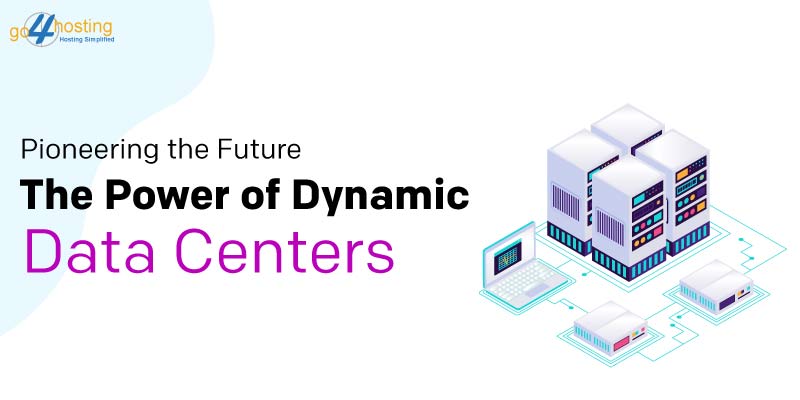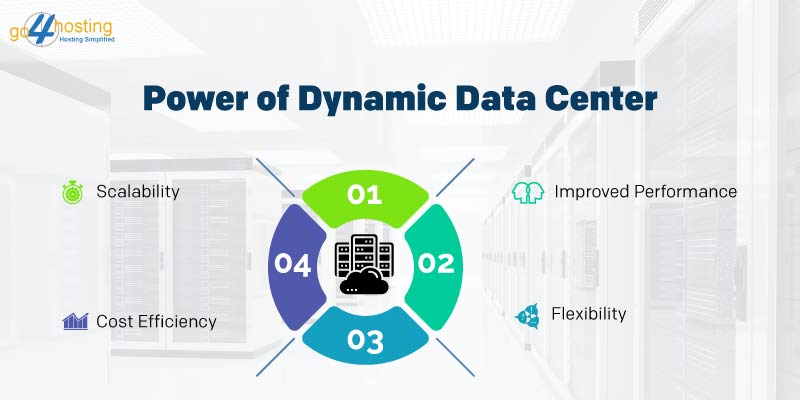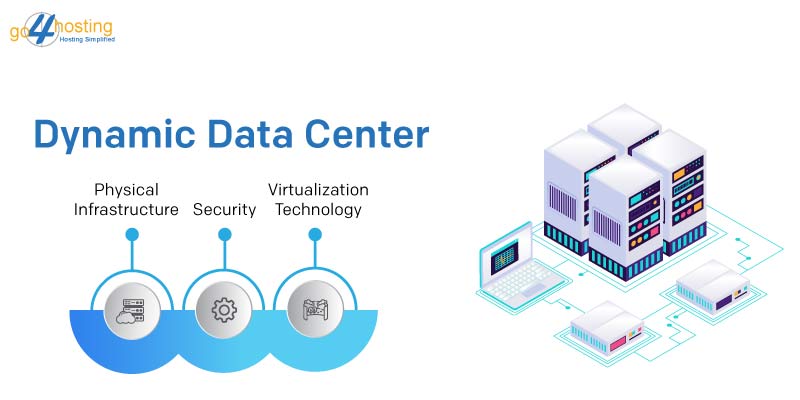Pioneering the Future: The Power of Dynamic Data Centers

In the ever-evolving landscape of technology, one fundamental truth endures: change is constant. As our world hurtles forward into an increasingly digital future, businesses find themselves confronted with a critical inquiry: How can they not merely keep pace but truly flourish within this dynamic landscape? This question resonates not only in boardrooms but also within the corridors of IT departments, leading to a profound transformation in our approach to data management and infrastructure. At the heart of this transformation lies a game-changer: Dynamic Data Centers.
Static data centers, once the stalwarts of information management, are now giving way to a new paradigm—the dynamic data center. This shift represents not only an evolution but a revolution in how organizations store processes and leverage data to fuel innovation and drive success.
Dynamic Data Centers and Their Core Components
Dynamic data centers represent the cutting edge of data management and infrastructure technology. These centers are highly advanced facilities designed to store, process, and manage vast volumes of digital information and services in an agile and adaptable manner.
At their core, dynamic data centers consist of several key components that work in harmony:

- Physical Infrastructure
It includes servers, storage devices, networking equipment, and power and cooling systems. These components are interconnected to form a robust and scalable foundation.
- Virtualization Technology
On top of the physical layer, dynamic data centers incorporate virtualization technologies. Virtualization allows for the creation of virtual machines and resources, effectively abstracting the hardware layer. This abstraction grants administrators the flexibility to allocate resources on-demand, optimizing efficiency.
- Security
Security is also a paramount component. Dynamic data centers implement robust security measures to protect sensitive data from external threats, incorporating firewalls, intrusion detection systems, and encryption protocols.
How do Dynamic Data Centers Differ from Traditional Ones?
Dynamic data centers diverge significantly from traditional data centers in several key ways. Traditional data centers are often characterized by static, inflexible infrastructure. They rely on fixed server configurations, which can lead to inefficient resource allocation and wasted capacity.
In contrast, dynamic data centers are highly flexible and adaptable. They embrace virtualization and software-defined technologies, enabling administrators to allocate and reallocate computing resources dynamically based on workload demands. This flexibility not only enhances resource utilization but also reduces operational costs.
Traditional data centers typically require manual intervention for most tasks, from provisioning servers to handling updates and maintenance. Dynamic data centers, on the other hand, automate many of these processes, streamlining operations and reducing human error.
| Aspects | Traditional Data Center | Dynamic Data Center |
| Agility and Scalability | Traditional data centers typically have a fixed infrastructure that is not easily scalable. Expanding typically demands a substantial investment of time, energy, and financial resources. This limited agility can impede a company’s capacity to address evolving business requirements swiftly. | Dynamic data centers are designed with flexibility in mind. They can swiftly adapt to changing workloads and resource demands. Scalability is a core feature, allowing businesses to expand or contract their IT resources as needed easily. This agility ensures that organizations can respond promptly to market fluctuations and evolving customer demands. |
| Resource Allocation | Traditional data centers often statically allocate resources, with fixed allocations for each application or service. It can lead to underutilization of resources and inefficiencies, as certain applications may have excess capacity while others face resource shortages. | Within dynamic data centers, resources like computing power, storage, and bandwidth are allocated in real time, adapting to immediate demands. This approach ensures resource efficiency and minimizes waste. The utilization of automated provisioning and resource management tools is instrumental in the optimization of resource allocation. |
| Cost Efficiency | Traditional data centers may incur higher operational costs due to resource inefficiencies and the need for manual management. The fixed infrastructure can result in over-provisioning of resources, leading to unnecessary expenses. | Dynamic data centers are known for their cost-efficiency. By dynamically allocating resources and optimizing workloads, they can reduce operational costs and minimize hardware and energy expenses. This cost-effectiveness makes them an attractive option for businesses looking to maximize their IT investments. |
| Automation and Orchestration | Traditional data centers rely more on manual processes, which can be time-consuming and error-prone. This manual intervention can lead to delays and operational challenges. | Automation and orchestration are integral components of dynamic data centers. These technologies streamline routine tasks, such as provisioning, monitoring, and scaling, reducing the need for manual intervention. As a result, IT teams can focus on strategic initiatives and innovation. |
| Resilience and High Availability | Traditional data centers may require additional investments in redundancy and failover solutions, which can increase costs. Achieving high availability can be more challenging in a static environment. | Dynamic data centers are designed with resilience in mind. They often feature redundancy and failover mechanisms to ensure high availability of services. Automated failover and recovery processes help maintain service continuity in the event of hardware or software failures. |
4 Benefits of Dynamic Data Centers
Staying adaptable and responsive to change is not just a strategy; it’s a necessity. Dynamic data centers have risen to prominence as indispensable instruments in attaining this objective, fundamentally transforming how enterprises oversee their data and infrastructure. Let’s delve into the diverse array of advantages they offer.

- Scalability
Scalability is the linchpin of modern business success, and dynamic data centers offer an unparalleled solution. These centers are designed to adapt to evolving data requirements seamlessly. Whether your organization experiences sudden spikes in data volume or gradual growth, dynamic data centers can expand or contract to match your needs. This flexibility ensures that you never overinvest in resources you don’t require, making it a cost-effective choice for businesses of all sizes. By embracing scalability, you empower your organization to reach new heights without unnecessary constraints.
- Cost Efficiency
In an era where financial prudence is paramount, dynamic data centers shine as cost-efficiency champions. Traditional data centers often demand substantial upfront investments and ongoing maintenance expenses. In contrast, dynamic data centers optimize resource allocation, reducing wastage and unnecessary expenditures. By dynamically allocating resources based on real-time demands, these centers help you make the most of your IT budget. The result? Tangible cost savings that can be reinvested in critical areas of your business, fostering growth and innovation.
- Improved Performance
When it comes to performance, dynamic data centers are second to none. Their ability to allocate computing power precisely where it’s needed translates into enhanced system performance. Tasks that once lagged are now executed swiftly, boosting overall productivity. Furthermore, enhanced performance extends beyond mere speed in processing. It directly correlates with improved user experiences and heightened customer satisfaction. The utilization of dynamic data centers enables your business to consistently operate at its optimal efficiency, ultimately bestowing upon you a distinct competitive advantage within today’s high-pressure marketplace.
- Flexibility
Change is inevitable in the business world, and dynamic data centers are built to thrive in this environment. Their flexibility is a cornerstone of their value proposition. As your business evolves and pivots to meet new challenges, these centers adjust effortlessly. Whether you’re launching new products, entering different markets, or changing your IT strategy, dynamic data centers provide the infrastructure adaptability you need. This skill empowers your organization to respond swiftly to market dynamics and evolving customer expectations, ensuring you stay ahead of the competition.
.
Factors to Consider before Transitioning to Dynamic Data Centers
Before embarking on the journey to implement dynamic data centers, it’s crucial to weigh several key factors carefully. These considerations can significantly impact the success and efficiency of your transition:
- Current Infrastructure Assessment
Begin by evaluating your existing IT infrastructure. Understand its strengths and weaknesses to identify areas that could benefit from a dynamic data center solution.
- Scalability Needs
Determine your organization’s scalability requirements. Ensure that the dynamic data center can grow alongside your business without compromising performance or incurring excessive costs.
- Budget and Resources
Establish a clear budget for the transition and allocate the necessary resources. Be prepared for potential upfront investments and ongoing operational expenses.
- Data Security
Prioritize data security. Assess the sensitivity of your data and ensure that security measures are integrated into the dynamic data center architecture from the outset.
- Compliance and Regulations
Understand industry-specific regulations and compliance requirements. Ensure that your dynamic data center solution aligns with these standards to avoid legal complications.
- Staff Training
Invest in staff training and development. Ensure that your IT team is well-equipped to manage and optimize the dynamic data center effectively.
- Migration Strategy
Develop a comprehensive migration plan. Determine which data and applications will be transferred to the new environment and establish a timeline for the transition.
Tips for a Successful Implementation Strategy
To ensure a successful transition to dynamic data centers, follow these tips:
- Clear Objectives
Define clear and measurable objectives for the transition. Having a well-defined roadmap will keep the project on track.
- Vendor Selection
Choose a reliable vendor with a proven track record in dynamic data center solutions. Research and seek recommendations to make an informed choice.
- Testing and Pilots
Conduct thorough testing and pilot programs before full-scale implementation. Identify and rectify any issues during this phase.
- Monitoring and Analytics
Implement robust monitoring and analytics tools. Real-time insights will enable proactive management and optimization.
- Documentation
Maintain detailed documentation of the transition process, configurations, and procedures. This documentation is invaluable for troubleshooting and future upgrades.
- Scalability
Design the dynamic data center with scalability in mind. Ensure that it can accommodate future growth without major disruptions.
- User Training
Train end-users to adapt to the new environment. Their familiarity and comfort with the dynamic data center will enhance overall productivity.
Future Outlook: The Potential of Dynamic Data Center
The future of technology beckons, a thrilling yet unpredictable terrain. Within this ever-shifting landscape, one certainty shines bright: dynamic data centers are destined to wield an irreplaceable influence, charting the course for business and technology.
Dynamic data centers, propelled by their remarkable adaptability and scalability, harbor transformative capabilities that defy exaggeration. They have the potential to thrust businesses into a domain where nimbleness and efficiency reign supreme. Their innate capacity to seamlessly adjust resources in real-time aligns flawlessly with the ever-changing demands of enterprises within a volatile marketplace.
Furthermore, these centers are unshackled by geographical constraints, fostering a globally oriented approach to data governance. This liberation signifies that businesses can effortlessly extend their reach and explore new territories, free from the shackles of physical infrastructure constraints.
As we peer into the future, dynamic data centers will serve as instrumental catalysts in harnessing the complete might of emerging technologies, including artificial intelligence, edge computing, and the Internet of Things (IoT). They form the sturdy bedrock essential for processing and dissecting the monumental data deluge spawned by these technologies, propelling innovation to unprecedented altitudes.
In essence, dynamic data centers emerge as the architects of a future where businesses don’t merely react to change but actively embrace and steer it. They are the enablers of a digital renaissance, poised to reshape industries, unlock fresh horizons, and ignite the forthcoming phase of technological advancement.
Wrapping Up

The dynamic data center stands as an undeniable force shaping the future of businesses and technology alike. Its capacity to adapt, scale, and span the globe positions it as an invaluable resource in a swiftly evolving digital terrain. In our journey through the unexplored realms of emerging technologies such as artificial intelligence, edge computing, and the Internet of Things (IoT), dynamic data centers stand as unwavering allies, furnishing the sturdy foundation required to handle immense data volumes and propel innovation to unparalleled levels.
The importance of embracing dynamic data centers cannot be overstated. They empower businesses to not only keep pace with change but to lead the charge in a world where agility and efficiency are paramount. They optimize resource allocation, reduce operational costs, and enhance overall performance, giving organizations a competitive edge. In essence, they are the architects of a digital renaissance, unlocking new opportunities and fueling the next phase of technological advancement.





